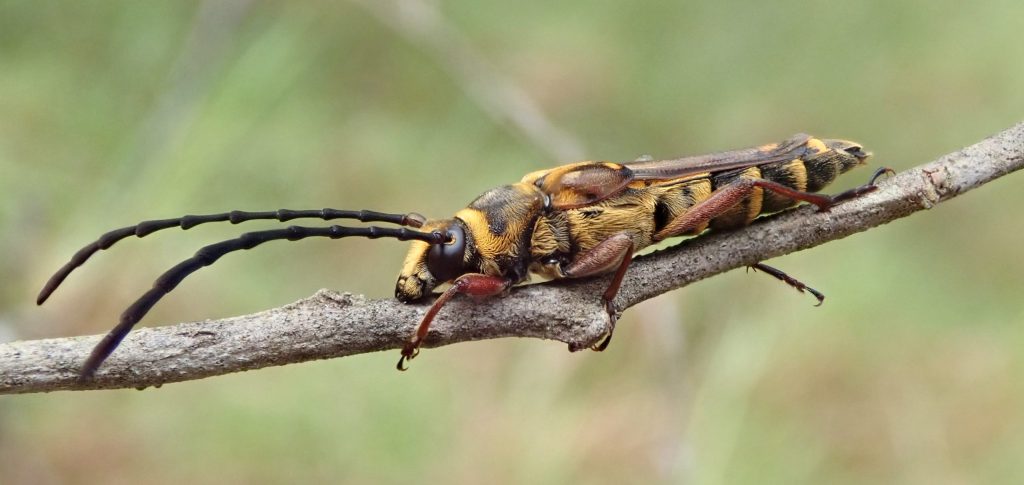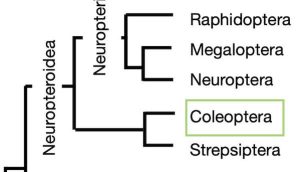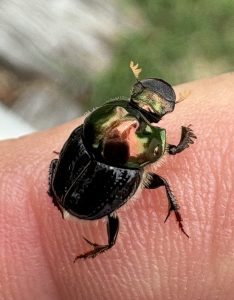34 Orders of Insects: Coleoptera


Order Coleoptera: Beetles
Coleoptera
- common name: beetles
- from the Greek: koleos=sheath, ptera=wings
- worldwide distribution and highly diverse: about 400,000 species; largest order in the Class Insecta; over 28,000 spp. in Australia; nearly 30% of all animal species are beetles!
- Found in almost all habitats; some aquatic species
- diverse feeding strategies: herbivores, predators, scavengers; some parasitic
- life cycle: holometabolous
Two suborders:
- Adephaga – the first abdominal sternum is divided by the hind coxae; includes ground beetles , tiger beetles (predominantly predaceous as larvae and adults)
- Polyphaga (largest suborder) – the first abdominal sternum is undivided; includes click beetles , lady beetles , blister beetles , darkling beetles, leaf beetles
Characteristics of Coleoptera
Adults
- very small to very large (0.25mm up to 10cm), body usually sturdy and compact
- mandibulate mouthparts; compound eyes in most; antennae highly variable
- fore wings are hardened into elytra (single = elytron); form a protective covering over the membranous hind wings which are folded beneath the elytra; hind wings are responsible for power in flight although some species lack hind wings, i.e. flightless
- Legs with various modifications
Immatures
- Immature stages (larvae) terrestrial or aquatic
- short antennae, chewing mouthparts
- legs may be present or absent
- highly variable
Longicorn beetle larvae boring through the wood of a poinciana tree. The larvae are legless and have strong mandibles to chew through the wood. Note the dark brown spiracles along the side of the body. [Photo: K.Ebert].
Food, Feeding Habits, Behaviour, Habitats
Herbivores
Beetles feed on a large range of plants and relatives: algae, fungi, conifers, angiosperms, dicotyledons, monocotyledons. Individual species are usually specialists. There are many specialisations within plant species e.g.foliage and flower feeders, stem and bark feeders (shallow borers), wood feeders (deep borers), root feeders, seed, nut and fruit feeders.
Fungus feeders
Many families or parts of families are associated with fungi. Fungi utilised usually have long-lived fruiting bodies – not toadstool type.
Keen to learn more?
Some interesting fungus feeders:
- Read about Ambrosia beetles that are “fungus farmers” and cultivate fungi in dead trees.
- A few Australian native dung beetles are mushroom specialists: here is an older paper that shares the interesting behaviour of Onthophagus dunningi.
- And here’s some information on the fungus-feeding lady beetle.
Predators
Many species are predatory; some are primarily-predaceous species eating freshly killed animals, e.g. tiger beetles, some are primarily-scavenger species and they may feed on other scavengers. Predaceous beetles generally are more active than herbivores, except those that specialize on slow moving prey. The head is generally more prognathous and mandibles have pointed incisors. About 25 families are primarily predaceous. Most are generalists but a few are specialists e.g.:
- ground beetles (Carabidae): primarily nocturnal predators on ground
- predaceous diving beetles (Dytiscidae): aquatic predators
- whirlygig beetles (Gyrinidae): predators on water surface
- hister beetles (Histeridae): predators in carrion or dung,
- lady beetles (Coccinellidae): primarily aphid predators.
Predatory beetles: a lady beetle eating an aphid (top left), a diving beetle (Cybister sp.) eating an insect carcass (top right) and a predatory ground beetle (Carabidae) below.[Photos: K. Ebert].
Scavengers
Decomposing matter is rich source of energy, well exploited by beetles. It changes in quality as it ages e.g. felled trees, dung and carrion. It is often associated with a succession of fauna adapted to the different stages of decomposition. There is competition for limited, short-lasting resources e.g:
- dung beetles (Scarabaeinae) – in this subfamily, the adults’ mouthparts can process only soft moist dung; often bury dung in nest to prevent desiccation. Progression of behaviours from independent larval development in dung to parental provisioning of larvae by enclosing each egg in a ball of dung and burying it. A surprisingly diverse group. Australia has many native species adapted to native animal dung as well as some introduced species that bury bovine dung.

Parasites
Several beetles show early stages of ectoparasitism on mammals e.g. scavengers in nest. A few species are completely ectoparasitic on body of host. Parasitism of other insects (parasitoids) probably evolved from predators. The difference between predator and parasitoid is sometimes indistinct. Most advanced Coleopteran parasitoids undergo hypermetamorphosis – different forms during metamorphosis.
Kleptoparasitism: stealing provisions of others e.g. one weevil takes over the leaf roll prepared by leaf-rolling weevil; some dung beetles invade nests of others, kill resident larva and lay their eggs; some beetles kill ambrosia beetles and feed on their “fungus gardens”.
Myrmercophilous and termitophilous beetles – parasites in ant and termite nests; species from over 100 genera of Coleoptera found in social insect nests
Topic Review
Do you know…?
- the main anatomical features of beetles
- some of the diverse lifestyles of beetles

